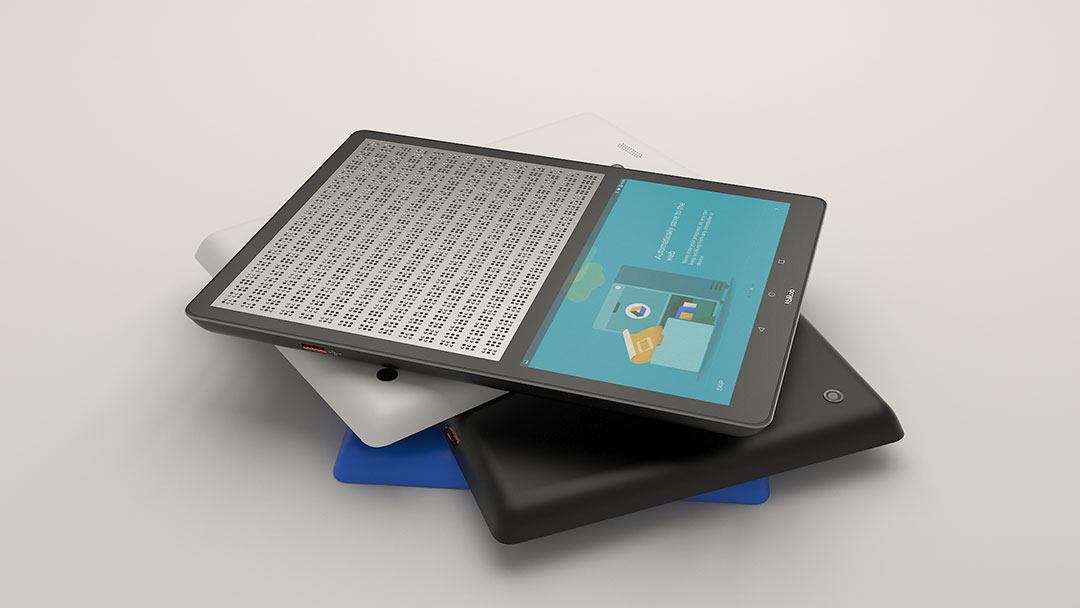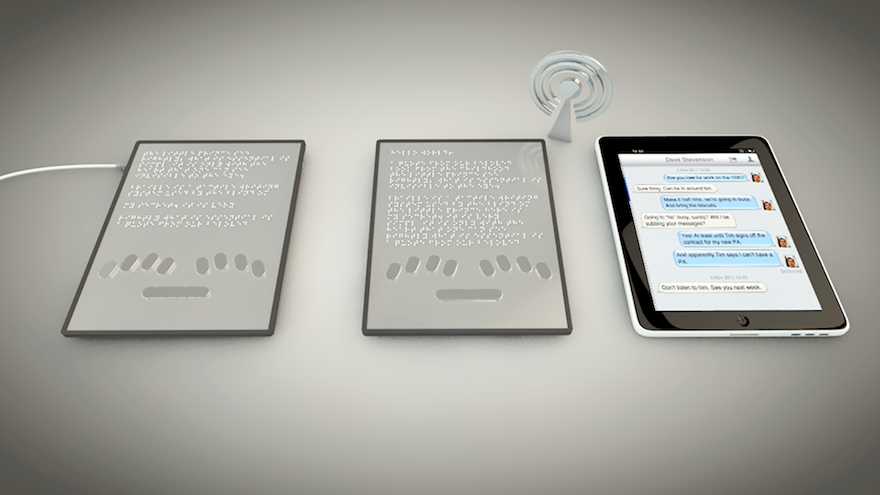Discover Cutting-edge Devices Made for the Visually Damaged
The development of cutting-edge tools for the aesthetically impaired stands for a considerable improvement in accessibility and self-reliance. Technologies such as smart glasses with AI capabilities and mobile applications designed to offer auditory descriptions are reshaping everyday experiences for customers. In addition, wearable tools that use haptic feedback boost environmental understanding, while modern Braille innovations provide new ways to engage with message. As these devices remain to evolve, their influence on the lives of those with aesthetic impairments increases crucial inquiries concerning the future of inclusivity and freedom in numerous aspects of life. What lies in advance in this technical landscape?
Smart Glasses for Navigation

Smart glasses developed for navigating are transforming the way visually impaired people interact with their atmosphere. These advanced tools make use of a mix of camera modern technology, expert system, and acoustic responses to provide real-time information about environments. By utilizing barrier detection systems, smart glasses can alert individuals to possible risks, allowing safer wheelchair in both strange and acquainted setups.
The combination of GPS technology further improves navigating abilities, allowing individuals to obtain acoustic instructions as they move. This hands-free strategy not just fosters independence yet additionally empowers visually impaired people to browse urban landscapes with increased confidence. Additionally, many clever glasses are geared up with attributes that determine sites and road indications, giving contextual information that enhances the user experience.
Additionally, the growth of these devices is continuously advancing, with business working to enhance the accuracy of item recognition and broaden the variety of navigational features. As wise glasses end up being a lot more cost effective and obtainable, they hold the potential to dramatically change day-to-day live for visually impaired customers. Eventually, these innovative tools stand for an important step toward inclusivity, offering enhanced flexibility and a greater feeling of autonomy for people browsing the globe around them.

Mobile Apps for Daily Living
Just how can mobile applications improve the day-to-days live of visually damaged individuals? Mobile apps are changing the way aesthetically impaired individuals browse their environments, handle everyday jobs, and accessibility details. These applications provide essential support through different capabilities, promoting freedom and enhancing lifestyle.
A number of ingenious mobile applications are designed especially for daily living. Apps like Be My Eyes attach aesthetically impaired customers with sighted volunteers using video telephone calls, permitting them to receive real-time assistance with jobs such as checking out labels or navigating unfamiliar areas. Likewise, Seeing AI, developed by Microsoft, uses artificial knowledge to explain surroundings, checked out message, and determine things, properly transforming a smart device into an effective tool for day-to-day help.
Additionally, navigation apps customized for the aesthetically impaired, such as Aira and BlindSquare, use audio-based directions and environmental info, allowing customers to traverse their environments securely and with confidence. Past navigation and instant help, mobile applications also support organization and job management, with functions that assist customers set pointers, produce to-do lists, and track visits. In recap, mobile applications function as important resources, equipping visually damaged people to lead even more independent and meeting lives.
Wearable Technologies for Support
Empowerment via innovation is significantly apparent in the realm of wearable gadgets developed to aid aesthetically impaired people. These ingenious devices incorporate seamlessly into everyday life, enhancing navigation and providing vital responses to individuals. For circumstances, wise glasses furnished with video cameras can check out and recognize faces text aloud, enabling individuals to interact more with confidence in specialist and social settings.
An additional notable development is using haptic feedback systems in wearable gadgets. These systems utilize resonances or other tactile signals to share information concerning the individual's environment, such as obstacles or modifications in surface, improving flexibility and security. Wearable modern technologies additionally consist of wristbands that attach to smartphones, alerting customers to notifications through subtle resonances, hence improving connection without dependence on visual signs.
As these technologies continue to evolve, they are not only enhancing self-reliance for aesthetically impaired individuals however additionally promoting a greater feeling of inclusion in society. By bridging the void in between obstacles faced in daily living and the potential for freedom, wearable technologies function as critical tools in the mission for equal rights and empowerment for those with visual impairments.
Sound Description Tools
Sound summary devices play a vital duty in enhancing availability for visually damaged people, providing them with the capacity to involve with visual media. AI-powered visual aids. These devices offer narrated summaries of crucial aesthetic components in movies, tv shows, and live review efficiencies, making certain that individuals can fully comprehend the context and feelings shared through visuals
Sound summary can be incorporated into various systems, including streaming solutions, movie theater screenings, and live theater. Several popular streaming services now consist of audio description as an ease of access attribute, allowing viewers to pick it easily. In enhancement to traditional media, specialized applications also exist, offering audio descriptions for art exhibits, museums, and various other cultural occasions.
The performance of audio description hinges on the ability of the storytellers, who should communicate aesthetic information succinctly without detracting from the original sound. Innovations in this field are also leading the way for even more customized experiences, where customers can adjust the degree of detail and pacing according to their choices.
Braille Innovations and Devices
Braille innovations and gadgets have actually significantly transformed the means visually damaged people connect with message and info. Modern improvements have actually resulted in the advancement of functional tools that enhance literacy and self-reliance among customers. Notably, Braille display innovations have evolved, permitting dynamic analysis experiences. These tools convert electronic message into Braille, enabling individuals to access a vast selection of info on computer systems, smartphones, and tablet computers.
In addition, mobile Braille notetakers combine traditional Braille input with modern capabilities, facilitating note-taking, scheduling, and record modifying on the move. Braille displays and notetakers. These portable tools commonly feature text-to-speech capabilities, linking the gap between Braille and auditory info
Furthermore, innovative Braille printers have actually arised, enabling individuals to create Braille tags, documents, and educational materials efficiently. This accessibility cultivates higher participation in specialist and academic settings, inevitably promoting inclusivity.
Furthermore, study right into clever Braille modern technologies continues to increase. Gadgets that include expert system are being explored to offer real-time navigating support and contextual details, enhancing the individual experience in diverse settings. In general, these advancements show a dedication to encouraging visually damaged individuals with modern technology, ensuring they can conveniently gain access to and engage with the world around them.
%20(1).webp)
Verdict
The development of ingenious tools for the visually damaged considerably improves self-reliance and lifestyle. Smart glasses, mobile applications, wearable innovations, audio description tools, and Braille innovations jointly empower individuals by giving important check here navigation support, environmental recognition, and boosted reading experiences. These modern technologies not only foster better inclusion however additionally advertise freedom in day-to-day tasks, inevitably contributing to a much more fair and accessible culture for aesthetically impaired individuals. Proceeded advancement in this area holds pledge for additional enhancements.
As wise glasses come to be much more budget-friendly and obtainable, they hold the potential to dramatically transform everyday life for visually damaged individuals. Mobile apps are changing the means visually impaired customers navigate their atmospheres, handle day-to-day tasks, and accessibility info. Applications like Be My Eyes connect aesthetically impaired individuals with sighted volunteers by means of video telephone calls, permitting them More Info to obtain real-time aid with jobs such as reading tags or navigating unfamiliar areas.Furthermore, navigation applications tailored for the visually damaged, such as Aira and BlindSquare, provide audio-based instructions and ecological info, making it possible for customers to traverse their environments safely and confidently.The development of ingenious devices for the aesthetically damaged substantially boosts independence and high quality of life.